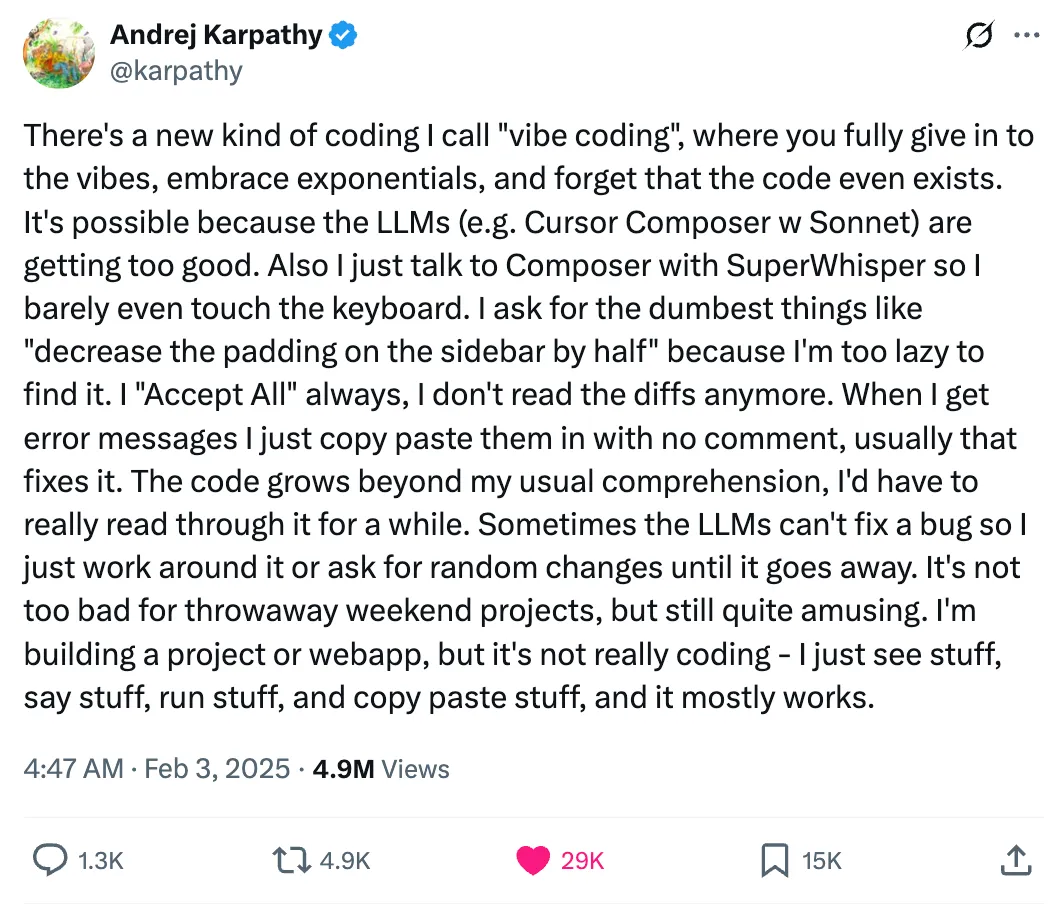Vibe Coding Your MVP
Harnessing the Power and Pitfalls of Vibe Coding
 Mohit R
Mohit R- 27 Apr 2025
In today's fast-paced tech world, getting your idea to market quickly is more important than ever. That's where vibe coding comes into play. If you've been hearing the buzz around "just vibe it" when coding, you're not alone. Vibe coding is the art (and science) of trusting AI tools, intuition, and lightweight coding practices to rapidly prototype and ship MVPs (Minimum Viable Products) often skipping traditional, heavy processes like detailed architecture or thorough code reviews.
As the world moves toward leaner, faster startups, vibe coding is becoming the secret weapon of many indie hackers, solopreneurs, and even early-stage startups. But it’s not without its trade-offs. Let's dive deep into how vibe coding started, how people are using it, and how you can responsibly leverage it to launch your next Micro SaaS.
What is Vibe Coding?
At its core, vibe coding is about letting go of perfectionism and letting creativity and momentum drive your development process. Instead of spending days or weeks planning, you jump into building often relying on AI coding tools like GitHub Copilot, Cursor, or Claude 3 to guide you. The philosophy is simple: build fast, validate faster.

This tweet by Karpathy gave name to the way half of us are secretly building projects now. You talk to your code (literally), accept all LLM suggestions without reading, copy-paste error messages, and pray it works. And guess what? It mostly does. For solo indie hackers, this lazy genius flow might just be the future.
Vibe coding as a trend gained momentum over the last year, fueled by better AI developer tools, a surge in indie hacker culture, and lean startup principles.
Platforms like Indie Hackers, X, and even Business Insider have reported how startups and solo founders are skipping traditional "spec-first" development models and embracing a "vibe first, polish later" attitude (source).
Visual Studio's latest preview even boasts features specifically designed for faster, more intuitive coding workflows, acknowledging that vibe coding is becoming mainstream (source).
Why Vibe Coding Feels Like a Superpower

1. Lightning-Fast MVP Development
One of the biggest advantages of vibe coding is the sheer speed at which you can move. Instead of spending days architecting a "perfect" backend or debating over front-end frameworks, you dive straight into building. By leaning on AI tools to scaffold boilerplate code, suggest patterns, and even debug minor issues on the fly, you can launch an MVP within hours or days instead of weeks.
In today's world where speed to market often decides success, vibe coding gives you an unbeatable edge to validate your idea before competitors even notice.
2. Lower Barrier for Beginners
Vibe coding democratizes product development. You don't have to be a senior engineer with a Computer Science degree to build something useful anymore.
With the help of smart code autocompletion, AI-driven code reviews, and intuitive no-code integrations, even beginners or non-traditional developers can ship real products.
This is incredibly empowering for indie hackers, students, creators, and professionals from non-tech backgrounds who have great ideas but lack formal coding experience.
3. Creativity Over Perfection
Vibe coding prioritizes momentum and creativity over strict discipline. By avoiding over-planning and premature optimization, you stay in a creative flow, trying new approaches, experimenting, and quickly iterating based on what feels right.
This mindset often leads to more innovative, unconventional products rather than "safe" but boring ones.
4. Immediate Feedback Loops
When you ship early and often through vibe coding, you can collect real-world feedback faster than teams stuck in months of development cycles. You don't guess what users want you show them something imperfect but working and let their feedback guide you. This minimizes the chances of building something nobody actually needs.
5. Lower Psychological Pressure
Because vibe coding embraces imperfections upfront, the mental pressure to "get it perfect" is massively reduced. When you know you're expected to just ship and iterate, it becomes easier to start projects without fear, build in public, and share early versions without shame. This mindset keeps momentum alive, especially in solo entrepreneurship where burnout and self-doubt are common.
The Dark Side of Vibe Coding

1. Security Vulnerabilities
In the rush to get things working, vibe coders often skip over basic security practices like proper authentication, rate limiting, input validation, or safe secret management.
This leaves MVPs open to serious vulnerabilities such as data leaks, brute force attacks, and API abuse.
2. Poor Scalability and Architecture
When you vibe code, you're focused on "making it work," not "making it last."
As a result, your app might work fine with 10 users but completely fall apart with 1000 users due to poorly thought-out database designs, monolithic services, and hacky code paths. Scaling vibe-coded MVPs later often involves painful refactors or even complete rewrites.
3. Non-Deterministic and Unpredictable Results
Since much of vibe coding depends on intuition and AI-generated code, outcomes are non-deterministic. The same prompt might generate slightly different code structures on different days. Even if it works initially, small hidden bugs or design inconsistencies can crop up later under real-world stress. You can end up with "spaghetti MVPs", tangled, brittle codebases that are very hard to debug or extend.
4. Technical Debt Accumulates Rapidly
Every shortcut you take during vibe coding builds up technical debt. Without regular refactoring, modularization, and code reviews, these debts snowball making future changes riskier and slower. If your product gains traction, you might find yourself stuck in a situation where small feature updates become multi-week headaches because the early code was too fragile.
5. Over-Reliance on AI (Skill Degradation)
When you vibe code heavily relying on AI tools, it's easy to fall into the trap of outsourcing too much thinking. You may start losing touch with fundamental skills like debugging, architecture planning, or security design. Over time, developers who lean entirely on vibe coding without consciously improving their core skills might find it hard to handle edge cases, optimizations, or critical failures without AI help.
Using Vibe Coding for Your Micro SaaS MVP
Micro SaaS is all about small, focused, and agile products solving specific problems usually built and run by solo founders or small teams. And vibe coding fits perfectly into this world. It lets you move fast, test ideas cheaply, and avoid months of over engineering before you even know if anyone wants what you're building.
Let's walk through how you can practically use vibe coding to bring your Micro SaaS ideas to life.
Tools to Vibe Code Your Micro SaaS MVP
You don't have to start from scratch anymore. There's a growing ecosystem of AI-powered tools and platforms designed specifically to accelerate vibe coding for indie hackers.
Some powerful tools you can tap into (source: IndieHackers Vibe Coding Tools):
-
Codex CLI: OpenAI's newly released terminal-based coding agent. It supports multimodal inputs like screenshots and diagrams and is powered by the latest o3 and o4-mini models, making it perfect for dynamic coding sessions directly from your terminal.
-
Cursor: A popular AI-enhanced fork of VS Code, Cursor comes packed with AI-first features. It not only suggests code completions and entire functions but also helps with database schema design, code refactoring, and has a strong, growing community around it.
-
Cline: A VS Code extension and sidebar agent with over 1.2 million installs. Cline easily integrates into VS Code, Cursor, and Windsurf, offering high-quality code suggestions by sending tokens to an LLM. It's incredibly powerful, but users should watch out for higher token usage costs.
-
Windsurf: A standalone AI code editor built on top of VS Code, boasting over 2.5 million installs. Windsurf offers smart tab completion, inline editing, and an integrated agent, all optimized to keep you in flow while vibe coding your project.
-
Claude Code: Anthropic's terminal-based coding agent, released in early 2025. Claude Code is particularly strong for developers who prefer powerful, conversational pair-programming experiences directly inside the command line.
Building MVPs to Validate Ideas (Fast and Cheap)
One of the biggest mistake early founders make?
Overbuilding before validating.
Vibe coding flips this mentality. Instead of trying to perfect a product for months, you can:
-
Build a landing page using AI tools like Framer AI or Typedream.
-
Spin up a basic app with a few key features (login, core workflow, simple dashboard).
-
Launch a working MVP to early users on Product Hunt, IndieHackers, Twitter/X, or Reddit.
-
Collect feedback, check if people actually pay for it, and then decide if it's worth scaling.
Check 8 vibe coders who are building real SaaS MVPs, not just games on how founders are using AI to build real SaaS MVPs in days, not months. In vibe coding, the goal is not to impress engineers it's to impress early users.
Use Vibe Coding with Caution in Production
While vibe coding is amazing for getting started, you must switch gears when you see early traction.
Here's what experts recommend (source: Vibe Coding for Dummies: 11 Tips):
-
Freeze AI-generated critical code early. Don't keep regenerating after launch or you'll introduce hidden bugs.
-
Add manual security layers. Use libraries that enforce good practices (like OAuth for auth, Stripe SDKs for payments).
-
Refactor slowly. Once you have users, spend a few hours each week cleaning up the "vibe mess" in your repo.
-
Prepare for handoffs. If you plan to hire freelance devs or collaborators later, keep your code readable and documented, not just "it works because vibes."
After getting your first few users, pause "vibe mode" and treat your codebase like a real asset, not a disposable prototype.
Micro SaaS + Vibe Coding = Superpower (If Used Right)
Vibe coding and Micro SaaS are a match made in heaven but only if you combine the freedom of vibe coding with the discipline of product thinking. Use vibe coding to start quickly, learn fast, iterate ruthlessly, but be ready to invest in stability once you find product-market fit.
In a world where speed wins, building with vibes might just be your biggest unfair advantage so if you're a solo founder or micro SaaS builder, embrace vibe coding to get your MVP out there. But remember: treat your early product like a disposable prototype. If users love it, refactor with care and prepare for growth. If they don't, move to the next idea with no regrets. In the end, vibe coding not about coding "perfectly." It's about building momentum.
Just vibe it. 🚀